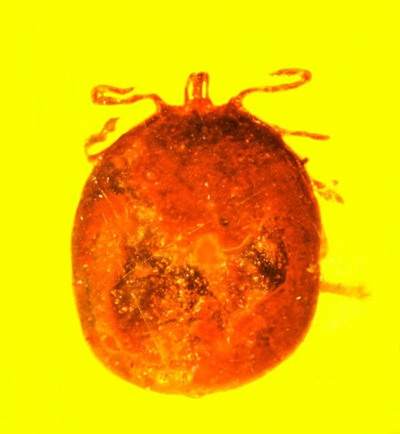
The 20 to 30 million year-old amber was a blood-engorged tick. (Photo: CGTN/ Oregon State University)
Researchers have found in a piece of amber what they believe to be the first fossilized red blood cells from a mammal.
The blood may be from two monkeys that were grooming each other about 20-30 million years ago in what is now the Dominican Republic, according to research published in the Journal of Medical Entomology.
Preserved so perfectly in amber that they appear to have been prepared for display in a laboratory, the cells were found together with what researchers say are the only known fossils of a type of parasite that still exists today, Babesia microti, which infects the blood cells of humans and other animals.
Two small holes in the back of a blood-engorged tick, which allowed blood to ooze out just as the tick became stuck in tree sap that later fossilized into amber, provide a brief glimpse of life in a tropical jungle millions of years ago.
"These two tiny holes indicate that something picked a tick off the mammal it was feeding on, puncturing it in the process and dropping it immediately into tree sap," said George Poinar, Jr., professor emeritus at the College of Science at Oregon State University (OSU).
"This would be consistent with the grooming behavior of monkeys that we know lived at that time in this region," said Poinar, author of the study and an international expert on plant and animal life forms found preserved in amber.
"The fossilized blood cells, infected with these parasites, are simply amazing in their detail."
In humans, the parasite B. microti can cause babesiosis, a disease with symptoms that resemble malaria and can be fatal.
A related parasite in cattle can cause Texas cattle fever, which has been a historic problem in the plains states in the United States. It has caused an outbreak that has led to quarantines on more than 500,000 acres, or about 200 square kilometers, of land in Texas this spring.
"The life forms we find in amber can reveal so much about the history and evolution of diseases we still struggle with today," Poinar said in a news release from OSU.
"This parasite, for instance, was clearly around millions of years before humans, and appears to have evolved alongside primates, among other hosts."


















































